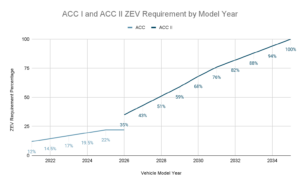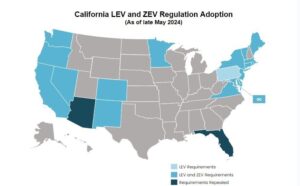The Advanced Clean Cars II Controversy: Where are States Adopting or Blocking California’s Zero-Emission Vehicle Rules?
By: Emily Apadula, Policy Analyst
California has long established itself as a national leader when it comes to environmental policy and regulation, and with the adoption of the Advanced Clean Cars II program, the state continues that legacy. While lawmakers in many states work to adopt or emulate similar emissions reductions programs, others are attempting to prohibit the adoption of these regulations altogether.
What is California’s Advanced Clean Cars Program?
California’s Advanced Clean Cars (ACC) combines several regulations, including the Low-Emission Vehicle (LEV) regulations and the Zero-Emission Vehicle (ZEV) regulations, into one package.The LEV program requires car manufacturers to introduce progressively cleaner light- and medium-duty vehicles. Meanwhile, the ZEV program increases the stringency of zero-emission vehicle sales and associated actions to support wide-scale adoption and use. While statutes regulating low- and zero-emission vehicles have been enacted in California since the 1990s, the first version of the ACCprogram was launched in 2012.
Advanced Clean Cars I vs. Advanced Clean Cars II
As stated above, both ACC I and ACC II build on previous California legislation designed to reduce the state’s greenhouse gas (GHG) emissions. ACC I, launched in 2012, focused on regulations for vehicle model years (MY) 2017 – 2025. As part of this program, vehicle manufacturer compliance with the Environmental Protection Agency’s GHG requirements for MY 2017 – 2025 would also serve as compliance with the state’s GHG emissions requirements for those same MY. The ZEV requirements for MY 2018 – 2025 were based on a credit system with the minimum requirement for each manufacturer including the percentage of passenger cars and light-duty trucks produced and delivered for sale within the state.

ACC II, adopted in late 2022, updated regulations for light- and medium-duty internal combustion engine vehicles MY 2026 – 2035 by reducing the allowable exhaust emissions, including emissions caused by evaporation. This program update also required an increasing percentage of ZEVs in new vehicle sales, culminating in a 100% requirement by 2035.
Why is the ACC program important?
The ACC program provides a gateway for states, in addition to California, to adopt vehicle emissions regulations that are more stringent than those set by the federal Clean Air Act (CAA). To make a long story short, California is the only state in the nation that is permitted to adopt its own emissions standards regulations for vehicles. The CAA grants specific authority to California, allowing the state to set its own separate and stricter-than-federal vehicle emissions regulations. Unlike California, under the CAA, other states are not allowed to create their own standards. However under Section 177, other states are allowed to adopt California’s motor vehicle emissions standards, thus allowing the adoption of more stringent rules.

The following states have adopted ACC I LEV and ZEV regulations as is, unless otherwise noted.
In 2008, Arizona’s Department of Environmental Quality (ADEQ) adopted the LEV standards including the ZEV sales and GHG emissions requirements, applying to passenger cars and light-duty trucks beginning with MY 2012 for traditional pollutants and MY 2013 for GHG emissions. Four years later, this was repealed by a formal rulemaking process.
In addition to ACC I regulations, in 2023, Colorado partially adopted ACC II.The new emissions standards and requirements would begin in 2027 and require 82% of new passenger vehicles sold in the state to be ZEVs by 2032.
Adopted ACC I standards apply to new vehicles with a gross weight rating of up to 14,000 pounds. As of July 2022, these regulations also apply to medium- and heavy-duty vehicles. While the adoption of ACC II regulations was proposed in 2023, it was ultimately withdrawn.
Passenger cars and light- and medium- duty vehicles MY 2014 and later must meet ACC I requirements, with exception to the ZEV sales requirement. In November 2023, the state partially adopted ACC II regulation. The new regulations would apply to MY 2027 and later and require that 82% of new passenger vehicles sold in the state be ZEV by 2032.
In addition to ACC I regulations, the District of Columbia adopted ACC II regulations in December 2023, beginning with MY 2027.
LEV standards were adopted in 2008 and were repealed by administrative action in February 2012.
Maine adopted standards beginning with model year 2009.
The state Department of Environment may adopt regulations to exempt certain vehicles from the ACC I standards, including vehicles sold for registration outside of the state and vehicles that would be exempt from the LEV program. ACC II was adopted in September 2023.
In addition to ACC I standards, ACC II was adopted in March 2023.
ACC I standards apply beginning 2024.
ACC I standards apply to MY 2025.
New Jersey adopted both ACC I and ACC II (beginning with MY 2027), with allowances from the state Department of Environmental Protection for manufacturers who sell or lease qualified LEVs to earn and bank vehicle equivalent credits.
ACC I standards apply to MY 2026. ACC II standards were adopted in November 2023 and will apply beginning with MY 2027 and later, requiring that 82% of new passenger vehicles sold in the state be ZEV by 2032.
Standards apply to any new light-duty passenger car, light-duty truck, or medium-duty passenger vehicle sold, leased, imported, delivered, purchased, or acquired in the state. ACC II was adopted in December 2022.
Standards apply to all new passenger cars, light-duty trucks, and medium-duty passenger vehicles sold, leased, licensed, or delivered for sale in the state. Exemptions may apply. ACC II was adopted in December 2023.
Pennsylvania adopted standards with the exception of the ZEV sales requirements for MY 2008 and newer.
Rhode Island adopted ACC I in 2012.
ACC I standards apply to new vehicles with a gross weight rating of up to 14,000 pounds. ACC II was adopted in December 2022.
ACC I adopted 2021.
**On June 5, 2024 Governor Youngkins announced that Virginia will no longer participate in the ACC program as of the end 2024.
Washington adopted ACC I in 2021 and in December 2022, ACC II.
Recent Trends
Under Section 177, many states have adopted all or part of the ACC regulations; however, a recent trend in introduced bills shows an increasing number of states working to prevent ACC adoption or repeal those standards already in place. This backlash likely results from the ACC II’s requirement for 100% of new cars and light-trucks sold in California be ZEVs by 2035. This portion of ACC II has been the topic of much discussion and debate for legislators, advocates, and other concerned parties. Just last year, lawmakers in Wyoming introduced a joint resolution calling for a phase out in sales of new EVs in the state by 2035. While the resolution did not pass, it sent a clear message from the state, who’s economy largely depends on the production of fossil fuels.
The following states have introduced legislation that would prevent ACC standard adoption or repeal current standards.
Alaska
H.B. 375 (D) prohibits restrictions on the use or sale of motor vehicles based on the energy source of the vehicle.
Kentucky
S.B. 215 (E) prohibits state agencies from adopting vehicle emission standards that are identical to California’s requirements.
Louisiana
H.B. 515 (I) prohibits state agencies from restricting the use or sale of a motor vehicle based on the energy source used to power said vehicle.
Maryland
H.B. 1247 (D) and S.B. 1063 (D) prohibit the Administration and Department of the Environment from adopting the California Advanced Clean Cars II regulation to be effective for cars prior to model year 2030.
Minnesota
H.B. 1383 (I) repeals adopted vehicle classifications, emissions standards, and credit accounting requirements in statute based on the California Air Resources Board.
H.B. 1373 (I) prohibits state agencies from restricting vehicle purchase selections based on fuel types or mandate vehicle inventories based on fuel type. The bill would also prohibit state agencies from restricting the sale of passenger vehicles, off-road vehicles, farm equipment, or snowmobiles based on fuel type. The bill would allow dealers or retailers of those vehicles to sell any make, model, or year subject to dealership agreements and customer agreements. The bill would also repeal adopted vehicle classifications, emissions standards, and credit accounting requirements in statute based on the California Air Resources Board.
S.B. 1455 (I) prohibits state agencies from restricting the purchase or sale of motorized equipment based on fuel type. Motorized equipment includes passenger vehicles, recreational vehicles, boats, off-road vehicles, generators, lawn mowers, and farm equipment. The bill requires that any proposed rule that includes or incorporates reference to statute in another state be submitted to the relevant standing committees of the House and Senate at least 90 days prior to publication of the notice required to adopt the rule. The bill would also repeal statutes based on the California Air Resources Board which include vehicle classifications, emissions standards, and credit accounting requirements.
New Mexico
S.M. 2 (D) is a resolution requesting the Environmental Improvement Board to repeal its recently enacted EV mandate, and requesting the Board take no further action regarding EVs without first conducting a feasibility and economic analysis.
H.B. 76 (D) prohibits the Environmental Improvement Board from adopting or continuing rules that require manufacturers to produce or deliver for sale a certain percentage of ZEVs for a given model year.
Washington
H.B. 1183 (D) repeals a previously enacted law requiring the adoption of California vehicle emissions standards.
It is clear that there is an increasing divide among lawmakers when it comes to the adoption of ACC II standards, especially concerning the ZEV requirements. While California’s ambitious ACC II program remains popular with some, a growing number of lawmakers are working to prevent its adoption. However, with ever-expanding ZEV demand and many other programs and policies supporting ZEV adoption, the march towards 100% ZEV adoption is likely to continue in the absence of state targets, albeit at a slower pace.